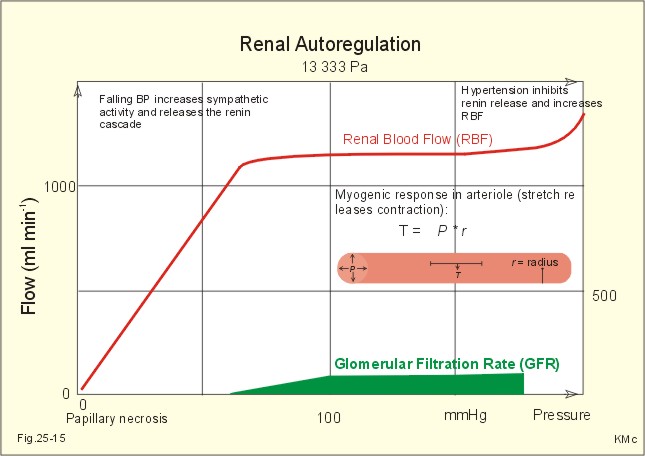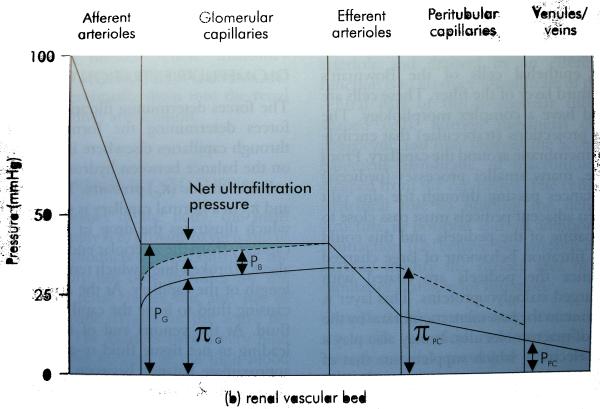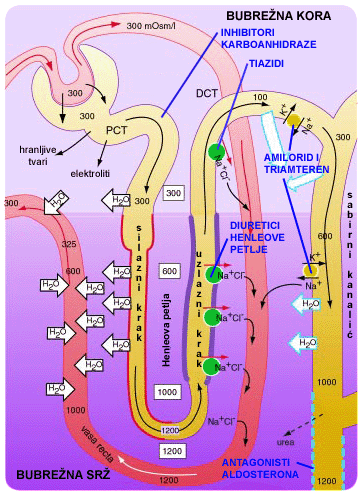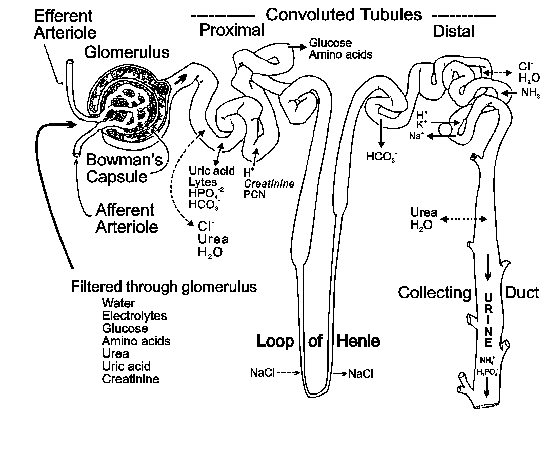Renal physiology
Each kidney contains 1-1.5 million nephrons and together, the kidneys receive 20-25% of cardiac output. 93% of this is destined for the cortex and as a result, the cortical oxygen extraction is very low (15ml/l). Approximately 50% of the oxygen consumed goes to support sodium reabsorption. By contrast, the inner medulla receives a blood supply barely adequate to meet its oxygen requirements (1% of RBF) and has a high oxygen extraction ratio.
The kidneys produce lymph at a similar rate to urine (0.5 ml/min). This is probably used to return to the circulation proteins reabsorbed from the tubules
Renal blood flow
Remains constant across a wide range of systemic arterial pressure as a result of autoregulation. (review article RBF/GFR)

Renal blood can be measured indirectly by measuring renal plasma flow and calculating RBF from the haematocrit. In order to do this, it is necessary to have a substance which is both filtered and actively secreted (20% of RPF is filtered, 80% is not). PAH is such a substance, 90% being removed from the plasma in eah pass (N.B. This is only true when low plasma concentrations of PAH are used, otherwise the secretory mechanisms are saturated).
ERPF * PPAH = UPAH * V
RPF = ERPF * 0.9
RBF = RPF * 1/(1-Hct)
The nephron
Two groups of nephrons may be identified according to the lenghts of the loops of Henle. Cortical nephrons have short loops of Henle, while juxtamedullary nephrons (15% of the population) have longer loops wigh plunge deep into the medulla. The thin segment of the loop of Henle is much shorter in cortical nephrons and they lack the vasa recta. Any change in blood distribution (ADH) between the two populations will have an effect on sodium reabsorption.
Glomerulus
Scroll down to image map for links to each cell-type.
The capillary endothelium of the glomeruls has pores of about 60nm. Immediately below the endothlium is the continuous barier of the basement membrane which contains large numbers of negatively charged collagen and glycoprotein molecules. Below the basement membrane, are the foot processes of the podocytes which are separated by 20nm. The podocytes also present a negative charge as they contain sialoglycoproteins. The presence of these negative charges has an effect on the filtration of charged molecules (Fig.1)
.
GFR is abour 125ml/min. The main determinant of whether a substance is fitered is molecular size. Molecules of up to 6nm (70kDaltons) are freely filtered, but as illustrated n the graph above, charge also plays a role, with albumin (69kDa) being filtered only about 1/20 as freely might be expected on the basis of size alone.
Glomerular filtration
GFR accounts for about 20% of RBF and depends on the balane of pressure and oncotic gradients between the glomerular capillary and tubular lumen (Peff), the glomerular filtration area (A) and the water permeability of the glomerular filter (k). The product of the latter gives the ultrafiltration coefficient (Kf
Kf = kA
GFR = Kf( (PGC + πT) - (PT + πGC) )
Since large molecules do not enter the tubule, πT is usually negligible and may be ignored. As a result, the changes in |Peff across the length of the nephron are as shown right.

| Afferent | Efferent | |
|---|---|---|
| PGC | 45 | 45 |
| PT | 10 | 10 |
| πGC | 20 | 35 |
| PGC-PT-πGC | 15 | 0 |
Filtration fraction
Renal bood flow is large (about 1.1l/min), but only the plasma component is available to be filtered (about 600ml/min). Of this, around 120mls (20%) are filtered. This is the filtration fraction.
Tubular transport
This is brought about by a number of mechanisms:
- Primary active transport
- Secondary active transport
- Ion channels
- Paracellular movement
- Transcellular movement

|

|